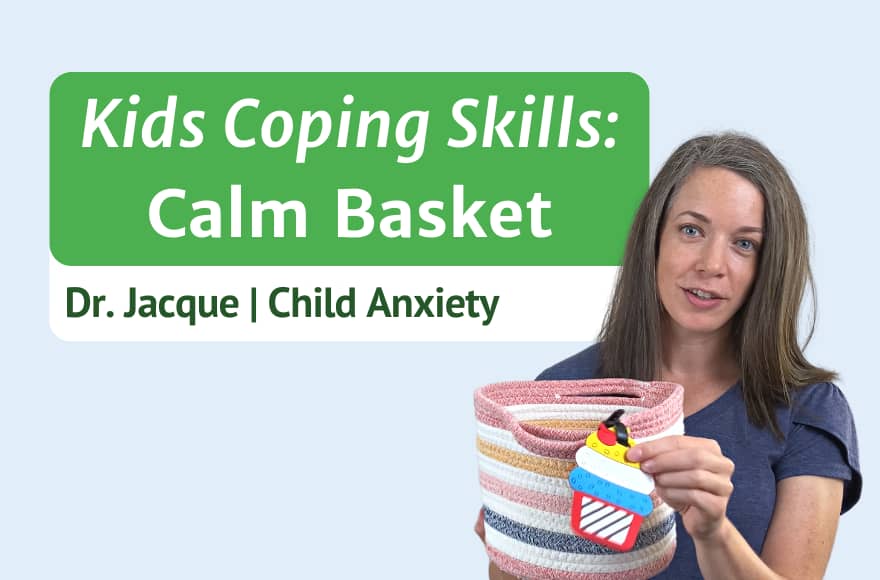Video Transcript & Notes:
If you want to teach your child to manage big feelings on their own, help them create a physical reminder of their coping skills. In this video, I will show you how to build a calm basket and how to help your kids use it when they feel overwhelmed, anxious, angry, or any other big feelings.
Stick around till the end to see what I have in my own calm basket – yeah, they are great for parents too! You can even use your own basket to model for your child, or use them together when your child is struggling.
Hi, I’m Dr. Jacque. I’m a psychologist, specializing in child anxiety. If you are new to my channel, be sure to subscribe and click the notification bell for more weekly videos to help families overcome fears and anxiety.
Building a calm basket is a great way to introduce kids to coping skills. It’s a physical reminder of skills and gives tangible options when your child is having big feelings. It takes out the problem-solving and decision-making when your child’s brain is already overwhelmed with emotions.
Include items in the basket that engage your child’s senses –
Sound (headphones),
Touch (push pop toys or stuffed animal),
Smell (smelly stickers),
Sight (look and find book or draw pad), and
You could also include taste, depending on the age of your child (gum, hard candies, ring pops)
And then include items that help bring down the body’s physical reaction to stress like stuff that helps with deep breathing (pinwheel) or muscle relaxation (squishy).
FULL LIST of Calm Basket contents – https://www.amazon.com/shop/childbehaviordoc?listId=2OD4CWSRZWYV6
(we may earn a commission if you buy via the link above)
Tailor the items to your child’s interests and age. Baskets are great for school-age and up. But even toddlers and preschoolers can get the idea with a little extra help and guidance.
If you found this video helpful so far, I’d appreciate it if you tap the like button and let me know!
So once you collect items for your child’s basket. Or maybe you go to a store or look online together, you need to teach your child how to use it.
Say something like, “you know, it’s my job as your mom to help you with things that are hard. Knowing what to do to feel better when we have a hard time can be really tough.” Then you could pause and give an example of a situation that was hard and give your child room to respond.
And then say, “it can be helpful to have options ready to try when we’re feeling worried/sad/angry etc. then when I’m not feeling my best, I can just try different things and see what might help.”
Then show your child what each item is for and how to use it. If you have a younger child, maybe start with just 2 or 3 options, and gradually add a few more over time. Practice using each one together. You can also switch out items as kids grow, get bored with them, or don’t show interest.
Last thing, after you’ve introduced your child to the basket and the items in it, and practiced several times when calm, decide together, when the basket might be useful. Keep in mind, it will not be helpful at the height of emotions. Using tools in the basket will work best when emotions first start to rise, or as a person begins to come back down. Think of the big emotions as a mountain. Scatter items along the climb up and down, but not at the tippy top. You and your child’s job at the tippy top of an emotion is just to get through the moment safely.
As I said in the beginning – calm down baskets don’t just have to be for kids. Grown-ups can have them too. The principles are the same: choose things you like that engage your senses or help relieve physical stress. You can even use your own basket to model for your child, or use them together when your child is struggling.
Here’s what’s in my Calm Basket: https://www.amazon.com/shop/childbehaviordoc?listId=SNYHFI5DR8AU
(we may earn a commission if you buy via the link above)
I’d love to know in the comments how this works for you and your kids. Which items do you and your kids love to use the most?
If you found this video helpful, click the like button and be sure to subscribe so I can continue helping families overcome kids fears and anxiety.
